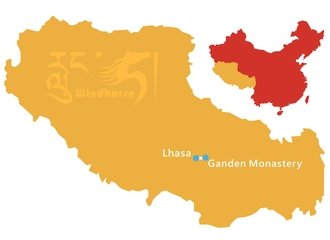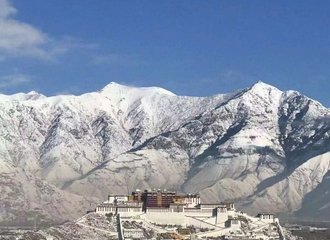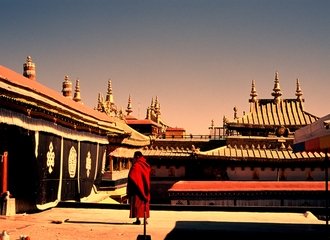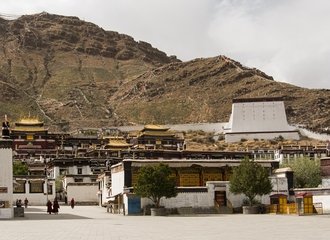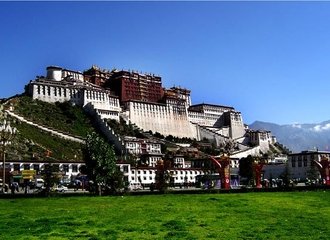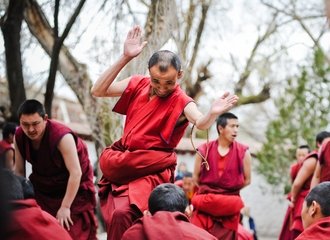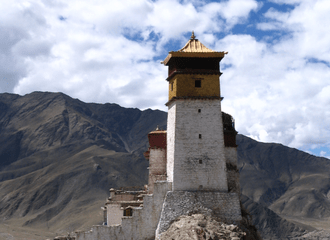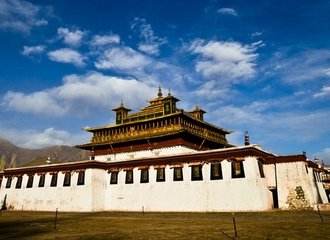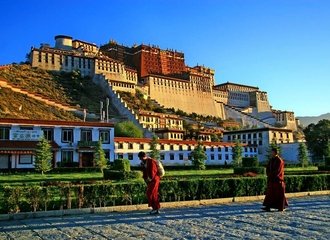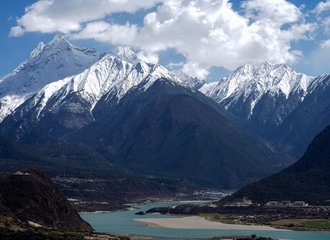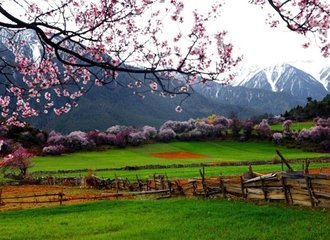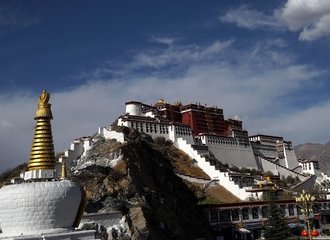Tashilhunpo Monastery
Tashilhunpo Monastery is one of the Six largest Monasteries of Gelugpa in Tibet. The monastery is located at the foot of Drolmari (Tara's Mountain), Shigatse. Founded by the First Dailai Lama in 1447, the

monastery's structure was expanded by the Fourth and successive Panchen Lamas. Tashilhunpo Monastery covers an area of nearly 300,000 square meters. The main structures found in the Tashilhunpo Monastery are The Maitreya Chapel, The Panchen Lama's Palace and The Kelsang Temple. Tashilhunpo is the seat of the Panchen Lama since the Fourth Panchen Lama took charge in the monastery, and there are now nearly 800 lamas.
Standing at the entry of Tashilhunpo, visitors can see the grand buildings with golden roofs and white walls. The remarkable Thangka Wall which is nine floors high was built by the First Dalai Lama in 1468. The wall displays the images of Buddha on the 14th, 15th and 16th of May every year following the Tibetan Lunar Calendar. The images are so humongous that one can easily see it in Shigatse City. Visitors can find The Maitreya Chapel by strolling into the monastery on the west side of Tashilhunpo. One can find the biggest statue of a sitting Maitreya Buddha inside the chapel. The statue stands 26.2 meters high and is decorated with gold, copper, pearl, amber, coral, diamond and other precious stones. The statue was handcrafted by 900 craftsmen in 9 years. The chapel has been divided into five floors. Visitors can tour the upper floors of the chapel using a wooden staircase to see the statue more clearly and appreciate the superb skill of the Tibetans.
The Stupa-tomb of the Tenth Panchen Lama lies east of the chapel. Covered by 614 kg (1,354 pounds) gold, 868 precious stones and 246,794 jewels, the Stupa-tomb built in 1993 is the most splendid and costly mausoleum in China since the 1950s. The Panchen Lama's Palace which stands nearby the Stupa-tomb is a grand white palace mainly built during the reign of the Six Panchen Lama (1738-1780). It is still closed to tourists and local visitors alike. To the east of the Panchen Lama's Palace lies the Stupa-tomb of the Fourth Panchen Lama who is one of the most famous Lamas in Tibetan history. He is also the teacher of the Fifth Dalai Lama. His gorgeous stupa-tomb decorated with gold and silver was built in 1662. The Stupa-tomb of the Fourth Panchen Lama is the first stupa-tomb in Tashilhunpo.
The Kelsang Temple is one of the oldest and biggest buildings in Tashilhunpo. It is

- a colossal compound. The Main Chanting Hall is a place for lamas to learn the sutras and listen to the Panchen Lama's sermon. On the back end of the hall lies a 5 meters high statue of Sakyamuni. It is said that a part of Sakyamuni's relics was placed in it. Two chapels sit on both sides of the Main Chanting Hall. The left one is devoted to Tara, the goddess who is believed to be the avatar of Avalokitesvara. A White Tara is in the middle and two Green Taras on each side. The right chapel is dedicated to Maitreya Buddha. With a height of 11 meters, one can find the statue of Maitreya Buddha in the middle of the chapel. The statues of Avalokitesvara and Bodhisattva Manjusri created by the First Dalai Lama stands near the statue of Maitreya Buddha. The Great Courtyard of the Kelsang Temple is the place for lamas to practice and debate. The wall around the courtyard is covered by thousands of images of Sakyamuni in different postures and expressions.
Besides the grand palace and gigantic statues, the Tashilhunpo Monastery also treasures characteristic wall paintings. Because of the variety of shapes, resplendent colors and exquisite painting, the murals are considered to be another masterpiece of Buddhist art. Rare sutras, thangka, china and glass services of the Ming (1368-1644) and Qing Dynasties (1644-1911) are also invaluable assets found in the monastery. These are good relics for researching the history and society of Tibet.
Tips:
- Pictures taking is restricted . Generally, for photo it costs RMB 75 Yuan, and video RMB 1,500 Yuan. But you'd better firstly ask the lamas for permission.
- The Thangka Wall sits northeast of the monastery. The huge wall, 35 meters (115 feet) in height 40 meters (131 feet) in width, can be seen faraway. Founding in 1468, it was a memorial monument to commemorate the birth, nirvana and initiation into Buddhahood of Sakyamuni. On April fourteenth of Tibetan calendar every year, gigantic thangkas of Buddha will be displayed on the wall.


